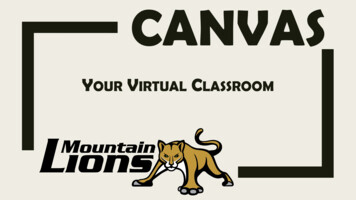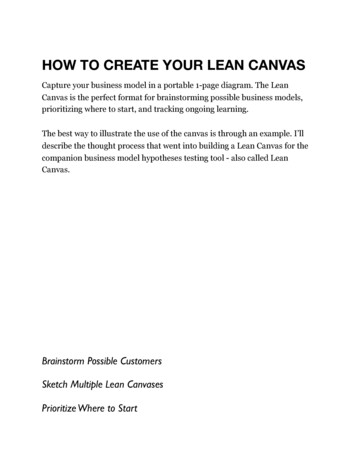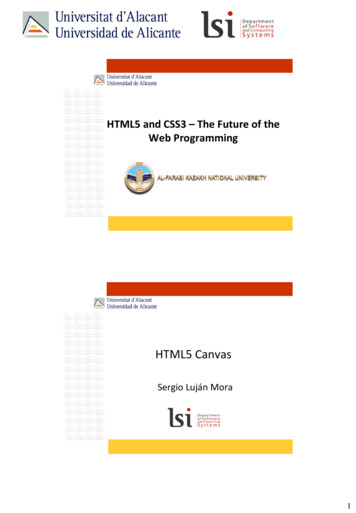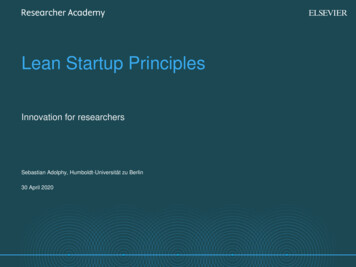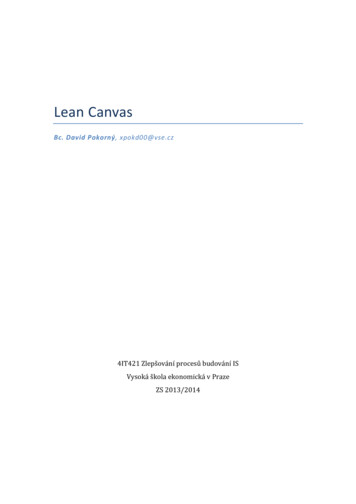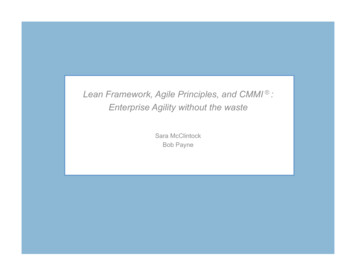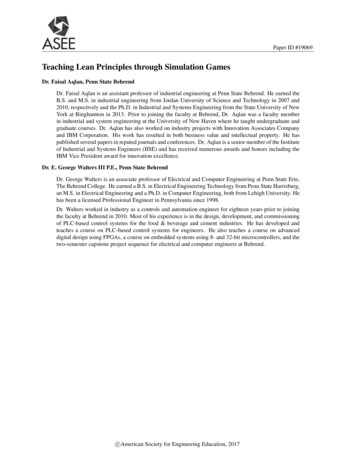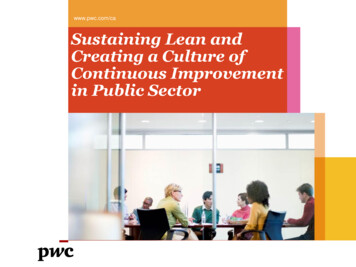
Transcription
DC COMMISSION ON THE ARTS AND HUMANITIESEntrepreneurial and Technical Training for Artistsand Small Business OwnersSpring 2019LEAN CANVASMETHODOLOGY OVERVIEWPresented by the DC Commission on the Arts andHumanities, the Department of Small and Local BusinessDevelopment, and the Office of Cable Television, Film,Music, and Entertainment1
WELCOMEThank you for joining us for the 2019 spring semester of The Business of the Arts.During the six-week program, facilitators from the Department of Small and LocalBusiness Development (DSLBD), Washington Area Lawyers for the Arts, and theDC Commission on the Arts and Humanities (CAH) will provide arts, humanitiesand creative professionals the knowledge and technical support to improve thesustainability of their business operations. From managing finances to perfectingyour brand story, each session guides you through key components of building asuccessful business and increasing your revenue.The Business of the Arts Professional Development Series is presented in partnershipby CAH, the DSLBD Innovation & Equitable Development Office, and the Office ofCable Television, Film, Music & Entertainment (OCTFME).Upcoming classes:Basic Business Financials, March 20Storytelling and Personal Statement, March 27Landscape on Access to Capital, April 3How to File Your Taxes, April 10Copyright and Trademark, April 17Register online at dcarts.dc.gov2
OVERVIEWLEAN CANVAS METHODOLOGYParticipants will work in groups of 3-5 to learn how to use the leancanvas module testing out business ideas, working through thelogic model, and getting used to basic pitching.At its heart, all business is selling, and all selling is storytelling.These activities will help prepare a framework for telling the storyof your business.TEAMS & ROLESBuilding a company starts with building the right team. There are roles and skills thatevery company needs, and there are sui generis opportunities that add great value.We’ll use the roles below for today’s exercise.CHIEF EXECUTIVE OFFICER (CEO)The CEO is the face of the organization, and sells the company to investors, buyers,and others who need to see why the company and its products or services are worthinvesting time and money. The CEO is a salesperson.CHIEF FINANCIAL OFFICER (CFO)The CFO handles the money. Whether it is debt or revenue, they manage andmonitor all aspects of ensuring that the company is profitable and can pay its bills.The CFO is the treasurer.CHIEF OPERATIONS OFFICER (COO)The COO makes sure that the actual work of the company happens, on time and onbudget. The handle everything that is day-to-day from hiring to purchasing suppliesand filling orders. The COO is a jack-of-all-trades.For larger teams, we will also include this role:INVESTOR. (BONUS!)Investors are not directly part of a company, but they fund the company. They areconcerned with whether the company will be profitable, and will often lend ideas,expertise, support, and network connections. The investor is a concerned friend.3
WHAT IS ANENTREPRENEURIAL IDEA?Entrepreneurial ideas solve problems. They offer solutions through a product ora service that consumers will pay for. Entrepreneurial ideas are successful when acompany can offer the product or service at a price that covers costs and has someextra for profit.For today’s exercise, teams can create an idea or use one of the ideas below.ON DEMAND SERVICES. SHARING A RESOURCE W/AN APPUber, Lyft, AirBnB, Task Rabbit an on demand-service is an app-mediated platformthat connects someone who needs a product or service with someone who canprovide it, quickly and directly.RESTAURANT/NIGHT CLUB/COFFEE SHOP/FOOD TRUCKPeople have to eat, and the city is full of options where people chose to eat andhave fun. Successful eateries have good food, but they also have a good theme andmanage tight cost margins to successfully make a profit.EVENTS MANAGEMENT. PRODUCE CONCERTS OR PARTIESEvents come in all shapes and sizes, and there are special skills for managing anevent efficiently and with style. Some event management firms specialize in aparticular type of event, while others are creative across the board.NOT-FOR-PROFIT. ALTERNATIVELY, SOCIAL ENTREPRENEURSHIPEveryone gives back to their communities one way or another, but some peoplemake giving back their core mission. These organizations may be non-profits thataccept charitable donations and grants, or social entrepreneurship in a for-profitcompany with a civic-focused mission.4
LEAN CANVASBUSINESS PLANNING. Fast. Concise. Effective.Activity: Break into groups of 3-4 people. Assign each person a role and select anentrepreneurial idea. Use the chart below to complete your plan.Problem Solution Unique Value Proposition(why I am different)Key Activity (how we dowhat we do)Cost Structure (money out) Revenue (money in)5
PITCH BASICSPitching a company is explaining to someone else what your company does, andwhy they should care. They may be an investor, an employee, a buyer, or a partner, orcustomer. Pitches can become more complex, but there is a core.For today, we’ll ask each of the designated roles to cover their portion of thepitch.WHAT DO YOU DO? CEO IS ON THE SPOT.In 1 minute or less, the CEO needs to tell the story of what the problem is, and howyour company solves that problem. You are selling this idea against the competition,or against the audience just going home.Problem. Solution. Unique Value Proposition. Why it is awesome, and why it willwork.HOW IS IT RUN? COO MAKES IT REAL.In 1 minute or less, the COO needs to build on what the CEO just told, gettinginto the nitty-gritty of how someone can actually make what the CEO just promisedhappen.Key Activity. Take what the CEO said and break it down. How will you make ithappen?HOW DO YOU MAKE MONEY? CFO COVERS THE BOTTOM LINE.In 1 minute or less, the CFO needs to explain that the awesomeness is not onlyaffordable, but it is profitable. They need to explain how much investment is needed,for how long, before sales start to cover costs, pay back loans, and exceed costs.Cost Structure. Revenue. Explain who pays what, and at once point profit scales.BONUS, INVESTOR. INVESTORS PROVIDE FEEDBACK.After the pitch, investors ask questions of concern and discuss what makes themmore or less likely to invest in this company’s ideas.Excitement. Concerns. Explain whether you would invest capital in this venture.6
PIVOTING, PEOPLE’S CHOICE& REFLECTIONOne of the most basic concepts of entrepreneurship today is the idea of the pivot.We pivot when we realize something that we are currently trying is not working, andwe need to try something else.Sometimes we change an entire idea. Sometimes we tweak it. Both are good, andboth are normal.Fail fast. Fail forward. Pivot and create a different success, but stay true to your story.And keep two exit strategies in mind: (1) best case scenario and (2) worst-casescenario.PEOPLE’S CHOICEWe have barely scratched the surface for thinking about the vast and diverse worldof entrepreneurial knowledge, opportunity, and support. With any time remaining,talk about other topics of interest and use to all entrepreneurs.Profit & LossContractingPartnershipsTractionRisk MitigationSocial MediaDebt Credit Scores Business BankingMentorship Legal Basics Crowd FundingMarketingHuman ResourcesEquity InvestingSales Regulation LoansTech Bankruptcy BondingContracts Consumer Protection BrandingAdvertising Peer Support WebsitesGrants Export InsuranceLicensing Incorporation HiringREFLECTIONAs time allows, as an entire group or in small groups, reflect on how the ideas fromtoday impact your outlook on endeavors in any arena. This could be in pursuing afuture business, or in taking an entrepreneurial spirit to any endeavor.7
ABOUTCAHEstablished in 1968, the DC Commission on the Arts and Humanitiessupports programs that promote progress in the arts and humanitiesthrough grants, professional opportunities, and other services toindividuals and nonprofit organizations in all communities within theDistrict of Columbia. CAH is the designated state arts agency for theDistrict of Columbia, and is supported primarily by District governmentfunds and in part by the National Endowment for the Arts.DSLBDThe Department of Small and Local Business Development supportsthe development, economic growth, and retention of District-basedbusinesses, and promotes economic development throughout theDistrict’s commercial corridors.OCTFMEThe mission of the Office of Cable Television, Film, Music, and Entertainmentis to produce and broadcast programming for the District of Columbia’spublic, educational, and government access (PEG) cable channels anddigital radio station; regulate the District of Columbia’s cable televisionservice providers; provide customer service for cable subscribers; andsupport a sustainable creative economy and labor market the District ofColumbia.8
LEAN CANVAS METHODOLOGY Participants will work in groups of 3-5 to learn how to use the lean canvas module testing out business ideas, working through the logic model, and getting used to basic pitching. At its heart, all business is selling, and all selling is storytelling. These activities will help prepare a framework for telling the story
